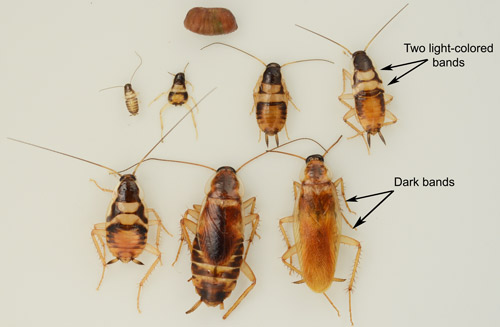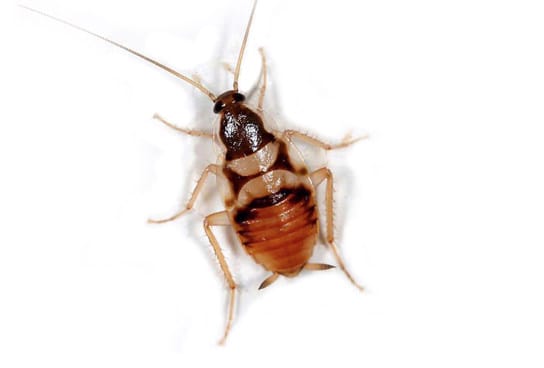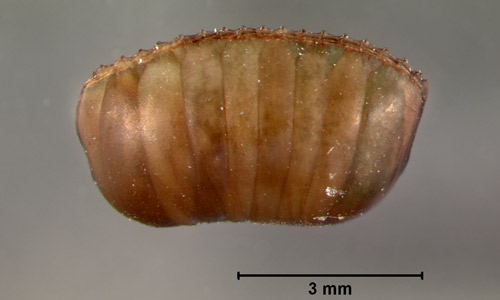You’re at your wit’s end trying to get rid of the brown-banded roaches crawling around your house.
You want them out. But you’re not quite ready to cut professional exterminators an expensive check.
The good news is, there’s quite a bit you can do to get rid of these pests without breaking the bank.
Here, we’ll go over all the information you need to eliminate these roaches for good.
Let’s dive in.
1. Identification
The first step to treating any cockroach infestation is identification.
You’ll need to identify if what you’re dealing with is a brown-banded cockroach.
Brown-banded cockroaches behave differently than other common household cockroaches such as American and German cockroaches.
It’s essential to identify what you have, so you’ll know exactly how to terminate them.
If you’re unsure, I recommend setting up a sticky trap.
Sticky traps attract roaches with a specific scent.
Once the cockroaches walk over the trap, the glue will prevent them from crawling out.
Place 6-8 of these traps around your house.
Some ideal places to put these traps are under appliances, inside cabinets, bathroom toilets, and near water sources.
Check your traps to get a good look at the cockroach you have.
Here’s what brown banded roaches look like:

It may take a few days to get a decent sample if you have a smaller infestation.
But, if with larger infestations, one day is typically enough.
2. Find Where They Live And Travel
Once you have confirmed that you’re dealing with a Brown-banded roach, you can start planning how to get rid of them.
Brown-banded cockroaches love dry and warm locations. They also like to be in high places, such as upper walls and cabinets.
Here are common locations where you’ll find them:
- Upper kitchen and bathroom cabinets.
- Near ceilings, light fixtures, crown molding, and electronics.
- Crevices in between cabinets, floorboards, and under appliances.
- In between and under couches or dressers.
3. Apply Gel Bait
Gel bait is highly effective at eliminating cockroach infestations because it administers tertiary kills.
When cockroaches ingest gel bait, they don’t die right away.
Instead, the roaches return to their homes where they defecate.
But gel bait turns roaches’ feces into poison.
And because juvenile roaches (nymphs) rely on feces to survive, the contaminated feces will kill them.
The termination doesn’t end there.
Once the nymphs die, they pass on the poison to the other cockroaches that eat their bodies.
So how do you apply bait gels?
Bait gel can take one of two forms.
- Bait Stations
- Syringe or Tube
Bait stations are small stations where roaches can access the bait.
While these traps are easy to move around, they can be limiting.
They don’t fit in many areas where roaches go, such as small holes and crevices.
Tubes or syringes, on the other hand, are more flexible.
You can easily apply them into tiny cracks and holes where roaches frequent.
When eliminating brown-banded roaches, I recommend using both forms of gel bait to cover all your bases.
Apply gel bait to all these targeted areas:
- Insides shelves and Cabinets
- On Top of cabinets and appliances
- Behind and under appliances
- In small crevices between cabinets, countertops, and appliances
- Crown molding fixtures
- Behind paintings, frames, and clocks
- Inside furniture
- On furniture such as tables, couches, and dressers
- Inside and around electronics
- Crevices between baseboards
The recommended amount is a pea-sized drop for every two feet.
Gel bait remains active for two weeks, so reapply accordingly.
4. Apply Dust Bait in Small Crevices
I recommend using dust bait in locations that gel bait is unable to reach.
Dust bait is a powder that comes with a small hand pump or tube.
They are perfect for reaching deep crevices and wall voids.
Similar to gel bait, dust bait kills roaches via ingestion.
When roaches walk over the dust, it will get all over their bodies.
Because roaches run their antennae and legs through their mouth, they will consume dust bait and die.
When using dust bait, only apply a very light layer. One to two pumps is typically sufficient.
Cockroaches avoid thick layers of dust because it is hard to walk through.
Applying dust bait to:
- Small crevices between cabinets, under baseboards,
- Under appliances
- On top of cabinets
- Under furniture
5. Use Insect Growth Regulators (IGR’s)
Adult cockroaches, pregnant females, and nymphs don’t consume the same food.
Pregnant females and nymphs rely on the feces of other adult roaches for food.
To cover all your bases, use IGRs in conjunction with gel and dust bait.
IGR’s are the equivalent of “birth control” for roaches.
They make adult roaches sterile and block a juvenile roaches’ ability to turn into an adult.
If adult roaches can’t reproduce and immature cockroaches are unable to grow into reproductive adults, their population will eventually die.
For easy in-home use, use IGR packets rather than sprays.
Break the pack to activate the hormone and place them where cockroaches usually travel and live.
For Brown-banded cockroaches, I recommend targeting your kitchen and bathroom.
But, if you see these critters on other rooms such as the dining room or bedroom, be sure to place them there.
For most, 1 IGR packet treats 50-75 square feet, so apply them to your home accordingly.
It is important to note that IGR’s take time to take work.
Don’t expect your infestation to shrink overnight.
Keep these packets active even after treatment.
It takes over 1-2 months for nymphs to molt and grow, so apply this method for around 7-8 months.
Most IGR applications last between 3 months, so you will only need to reapply 2-3 times before you eliminate your infestation.
6. Seal all Entry Points
Seal all entry points to prevent roaches from getting back inside your home.
If you had a roach infestation, you likely got it from a source near your home.
Roaches typically spread from house to house.
Do your due diligence and inspect both the inside and outside of your home carefully and thoroughly.
Examine your window and door seals for gaps.
Apply door flaps and seals to your door, to prevent roaches from crawling back in.
Check under your bathroom and kitchen sink, where pipes are protruding from the wall.
Check for tiny cracks and holes around your home.
Cover even the smallest holes you can find.
7. Apply An External Barrier Using Insecticide
The last step is to apply for external protection.
Use an outdoor insecticide and apply it around your house.
I recommend applying it up 3 feet on your walls and 3 feet on your floor’s surface.
Most insecticides are valid for 4-6 months, so reapply accordingly.
Don’t skip this step.
It’s much better to prevent cockroaches from getting into your house than dealing with them once they are inside your home.
Don’t stumble near the finish line.
You don’t want to go through all these steps only to have the roaches come back.
Frequently Asked Questions (FAQ)
What does an Adult brown-banded cockroach look like?

They have a light brown or yellow stripe on their wings, abdomens, and thorax sides.
Males have golden-tan color, while females have a darker brown.
An adult male has fully developed wings that stretch to the end of their abdomens.
While adult males can fly, they are more likely to jump when disturbed.
Females brown-banded roaches have little wings that cover only part of the abdomen. They cannot fly.
What does a baby brown-banded cockroach look like?

Juvenile baby brown-banded cockroaches (nymphs) have two light horizontal bands behind their heads that run horizontally across their bodies.
They have a dark brown color with an orange abdomen.
Nymph brown-banded cockroaches can be as small as a grain of rice.
What do Brown Banded eggs look like?

The Brown-banded cockroach has small, squarish, dark brown bodies.
They are much smaller than the other types of cockroaches.
Female roaches carry their young for a while before adhering them to a safe location.
Here are familiar places they’ll leave their eggs:
- Behind paintings, frames, items hanging on walls
- Ceilings
- Inside and on top of Furniture
- Walls
For large infestations, you’ll typically see these eggs bunched together rather than separated in a large area.
Where do Brown Banded Cockroaches hide?
These cockroaches love to be in warm, dry places.
They also love to be in higher locations, such as in upper kitchen and bathroom cabinets.
You’ll also find them congregating near ceilings, light fixtures, crown molding, and electronics.
While they prefer to be in higher places, they crawl in dark hidden areas such as crevices in between cabinets, floorboards, and under appliances.
These roaches are most active during the night; they avoid light during the daytime.
In larger infestations, you’ll find them in furniture such as couches or dressers.
These places give them easy access to food, warmth, and water.
How Serious of a Problem Are Brown-Banded Cockroaches?
Brown-banded cockroaches are quite severe because of how fast they can reproduce.
Female brown-banded cockroaches can lay around 12-14 ootheca in their lifetime with 12-18 eggs per ootheca. In 200 days, an adult female can produce 250 eggs.
If you see a brown-banded cockroach in your home, it’s vital that you address it immedietly.
Set up a sticky trap to find out if it’s just one roach or if it’s one of many roaches.
If you capture multiple roaches at different life cycles on your trap, you have a growing infestation in your home.
Are Brown Banded Cockroaches dangerous?
Yes. Brown-banded cockroaches are not only an inconvenience but also a health danger.
They walk around filth and feces and spread bacteria and other pathogens in your home.
These bacteria can cause salmonella and infections such as staphylococcus and streptococcus.
According to the World Health Organization (WHO), cockroaches can also cause dysentery, diarrhea, cholera, and typhoid fever.
Another often overlooked side-effect of cockroaches is the allergic reactions they cause.
Research by the Asthma and Allergy Foundation (AAFA) has shown that the enzymes found in excrement, shedding body parts, eggs, and saliva can trigger both allergic reactions and asthma attacks.
Having a Brown-banded cockroach in your home is especially concerning if you or your family member has asthma.
Do Brown-Banded cockroaches fly?
Both males and females have wings, but only the males can fly.
An adult male has fully developed wings that stretch to the end of their abdomens.
In contrast, females have little wings that cover only part of the abdomen.
You won’t see swarms of them male brown-banded roaches flying around.
In most cases, these cockroaches will jump rather than fly when disturbed.
Can brown-banded cockroaches trigger allergies?
Yes.
The enzymes found in their excrement, shedding body parts, eggs, and saliva can trigger both allergic reactions and asthma attacks.
Do brown-banded cockroaches live in drains?
No. Brown-banded cockroach prefers staying in dry and high areas.
You’ll typically see them on high off the ground, such as walls, ceilings, light fixtures, and furniture.
What are brown-banded cockroaches attracted to?
Brown-banded cockroaches are attracted to dark and warm places.
In terms of food, they will say nearly anything from food crumbs to grease.
These cockroaches also love to be near a reliable source of water.
Do Brown-Banded cockroaches carry diseases?
Yes, brown-banded carry dangerous diseases.
They walk around filth and feces and spread bacteria and other pathogens in your home.
These bacteria can cause salmonella and infections such as staphylococcus and streptococcus.
According to the World Health Organization (WHO), cockroaches can also cause dysentery, diarrhea, cholera, and typhoid fever.
Does having brown-banded cockroaches means your house is dirty?
No. Sometimes, even the cleanest home will have roaches.
These critters can live on pretty much anything, so they can find food source even if you clean regularly.
They will eat wallpaper, glue, hair, and books. So, while it helps to be clean, it’s pretty hard to starve them by merely cleaning everyday.
If your house is clean, and you are experiencing roaches, check if there are cracks and holes on your walls, doors, and windows.
They are likely coming from nearby areas through gaps and crevices around your home.
Why Did I Get American Cockroaches?
Cockroaches are very resourceful. They can enter your home in several ways, including:
- You are crawling through small holes and cracks around your home.
- Gaps around doors and windows.
- Hitching a ride on backpacks, grocery bags, suitcases, etc.
